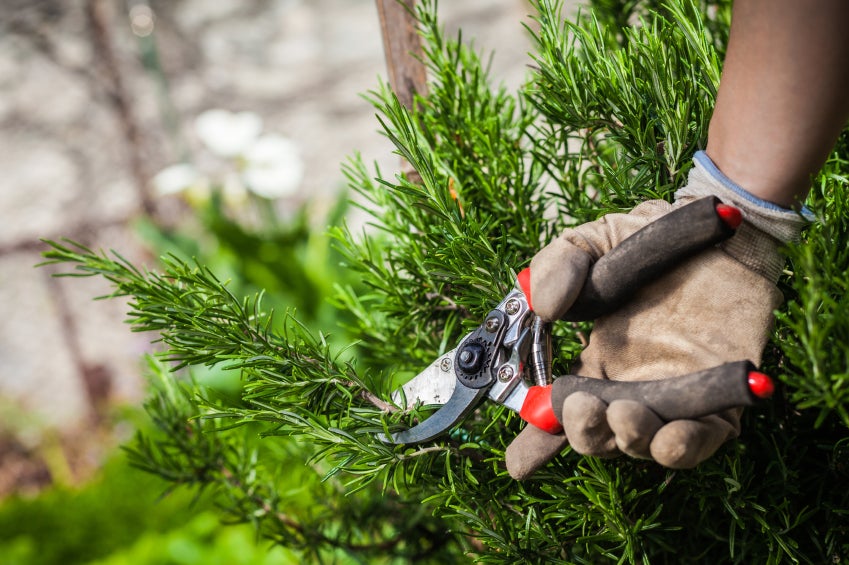How To Prune Rosemary For Better Looking Bushes & Loads Of Fresh Herbs
If you love your herbs you’ll want to know how to prune rosemary. A rugged and prolific plant, rosemary is a popular culinary, medicinal and ornamental staple in the garden.

How To Prune Rosemary For An Endless Supply Of Fresh Herbs
You may be wondering how to prune rosemary, especially if it’s one of your favorite herbs. Rosemary, Rosmarinus officinalis, is popular for its wide range of culinary, medicinal and ornamental uses. Its botanical name, Rosmarinus, Latin for “dew of the sea” is such a pretty name for a truly rugged plant. This fragrant herb is low maintenance and hardy in USDA zones 7-9 and on occasion, even into zone 6b. If you’re nurturing this well-loved herb, it’s worth learning how to trim rosemary.
Reasons for Pruning Rosemary
There are a few reasons why you might want to prune rosemary. For one, left unpruned, rosemary can become scraggly and rather unsightly. Pruning the plant keeps it tidy and compact. Of course, this isn’t strictly necessary if you would rather have a wilder, more untamed look.
Rosemary is often grown as a beautiful topiary which does require some pruning or tip pinching to train the plant into the desired shape.
Rosemary plants may end up with winter damage like broken tips or branches. In this case, it is best to cut the damaged part of the plant out, if only to avoid opening it up to disease.
The last reason to cut rosemary is to propagate it. Even the best cared for plant begins to die back after about 5-10 years. An easy way to continue to have rosemary in the garden or home herb planter is to propagate by cuttings.
When to Prune Rosemary
To control the shape and size of a rosemary plant, plan on pruning the plant back in the late spring or early summer. During the summer, you can also tip prune to control overgrown plants at any time, although ideally, you are harvesting from the plant, in which case it won’t likely need to be trimmed.
If you want to cut rosemary back in the fall, the plant requires 6-8 weeks to allow the growth to harden off before the first frost, so prune no later than early September.
Gardening tips, videos, info and more delivered right to your inbox!
Sign up for the Gardening Know How newsletter today and receive a free copy of our e-book "How to Grow Delicious Tomatoes".
If your plant has winter damage, cut back injured stems in late winter before new spring growth appears.
For propagation, take cuttings when the plant is actively growing but hasn’t bloomed in the late spring or semi-ripe cuttings in the late summer.
How to Prune Rosemary
When pruning your rosemary, never prune out more than 1/3rd of the plant. It won’t come back. Trust me on this. I’ve had a disastrous experience many years ago early in my gardening, hacking back half or over half the shrub and then wondering why it never came back.
In fact, I find that less is more. Prune judiciously and sparingly, especially if the plant is older and woody. Stick to removing the malleable tips of the plant rather than the woody branches. If you think you must prune more, take a cutting and start another plant before lopping the herb back.
To propagate the plant, take a 4-6 inch (10-15 cm) cutting from a green, shoot in late spring up until early summer.
Frequently Asked Questions
How Do You Trim Rosemary So It Keeps Growing?
Ideally, you will be using this aromatic herb and routinely trimming back the succulent, green tips which will keep it shaped and growing. If you haven’t used your rosemary and the plant is overgrown, cut it back by half, taking only the green, not woody portions of the stem in late spring or early summer.
Where Is the Best Place to Cut Rosemary?
The best place to cut rosemary is at the malleable, green tip. Avoid cutting into woody branches. Rosemary doesn’t take kindly to hard pruning. If you must cut out woody areas, try to stick to those that are withered, old, and/or diseased.

Heather Rhoades founded Gardening Know How in 2007. She holds degrees from Cleveland State University and Northern Kentucky University. She is an avid gardener with a passion for community, and is a recipient of the Master Gardeners of Ohio Lifetime Achievement Award.
-
 Looking For Plants To Give You The Soft And Fuzzies? Try These 5 Fuzzy Leaf Plant Options
Looking For Plants To Give You The Soft And Fuzzies? Try These 5 Fuzzy Leaf Plant OptionsLovers of texture, drama, silver foliage and tactile plants will adore these special sensory garden additions. These fuzzy leaf plant options will leave you all aglow
By Susan Albert
-
 Get Ready For A Summer Of Hummers! Grow These Full Sun Hummingbird Plants and Flowers
Get Ready For A Summer Of Hummers! Grow These Full Sun Hummingbird Plants and FlowersIf you’re lucky enough to enjoy a sunny backyard, make sure you are maxing out on your pollinator opportunities and grow these full sun hummingbird plants and flowers
By Tonya Barnett
